Well first, what is pool shock? Shock is a concentrated chemical formula used to increase available or free chlorine when your standard sanitizer (regular chlorine tabs, a salt chlorinator, Nature2, etc) gets behind in its duties. Sanitizers work to oxidize or break down organics and destroy bacteria. But they can become overwhelmed by higher levels of these compounds which rise after an increased bather load (pool party!) or heavy debris from inclement weather.
Organics come from many sources – dead skin cells, sweat, sunscreen, dirt, and leaves, to name a few. These not only muck up your pool but also provide a veritable all-you-can-eat buffet for bacteria and can set the stage for an algae bloom. This is when pool shock comes in to save the day by giving a boost to your sanitizer. Here are the three main types of pool shock, which vary by their chemical composition.

Cal-Hypo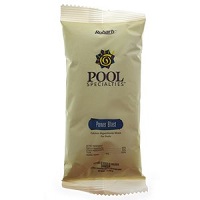
Its full name and main ingredient is calcium hypochlorite. Cal-Hypo contains chlorine and is available in different concentrations; we carry 68% and 73% which is typical of the ranges you’ll find. It will boost your free chlorine level without increasing cyanuric acid (CYA). However, since CYA acts as sunscreen for chlorine, you will want to add Cal-Hypo shock in the evening to give it a chance to work without getting hammered by full sun.
Cal-Hypo will add calcium along with the chlorine. If the calcium hardness level is already high in your pool, consider an alternate shock. Use with extra care on pool surfaces prone to bleaching, especially vinyl liners.
Di-Chlor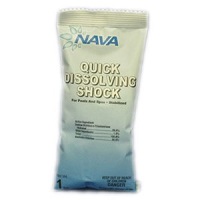
Also known as sodium dichloro-s-triazinetrione, Di-Chlor is another chlorine-based shock. This is typically recommended for vinyl liner pools as it dissolves rapidly and will not bleach or stain the liner. It is also safer for fiberglass or painted surfaces for the same reason.
Di-Chlor does not add calcium so it’s a good option over Cal-Hypo if you want to use a chlorine shock without increasing hardness.
Oxidizer (Non-Chlorine)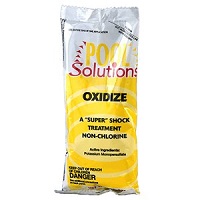
Potassium monopersulfate is an oxidizer comprised of potassium salt. There is no chlorine in this type of shock and it does not kill bacteria. So what’s the point? When there is a high level of organic waste in the pool, the available chlorine is used up attacking that, giving bacteria free reign to grow. Non-chlorine shock oxidizes the organics and helps clarify pool water. This allows the free chlorine to do its job of attacking bacteria and algae instead.
Some people prefer to limit the use of chlorine due to health concerns. Non-chlorine shock is not as powerful as Cal-Hypo or Di-Chlor but provides an effective alternative.
Whatever type of pool shock you decide to use, be sure to carefully follow the manufacturer’s instructions to protect yourself and your pool. And if you can’t get enough of the joy of pool maintenance, then check out our many How To Guides on this very subject.

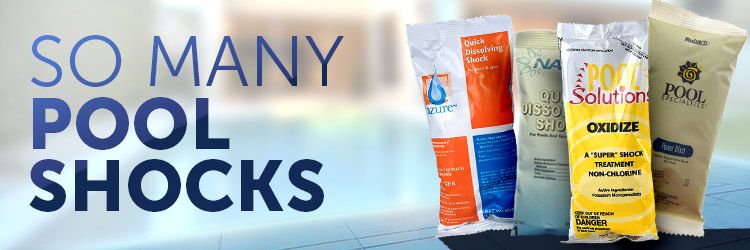
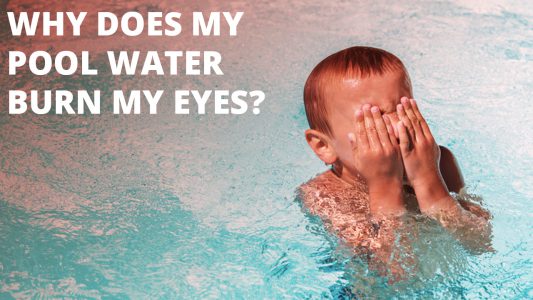
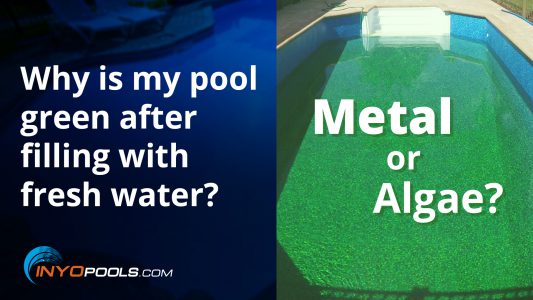
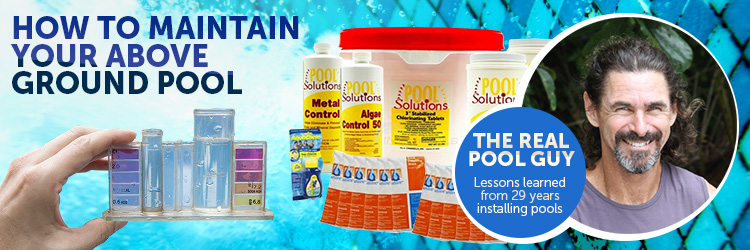
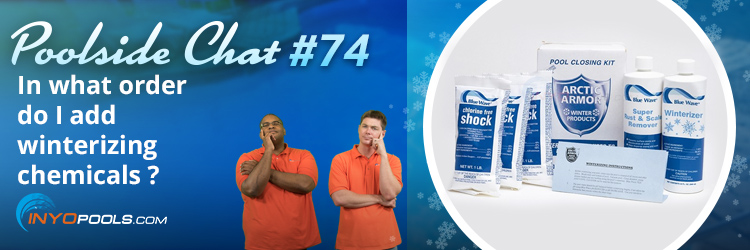






My pool is 16 by 36 and it is clear but I can not get a free chlorine reading.Total is 3 free is 0 cya is150 and total alt. Is 120 ph is 7.2 and the grandchildren are wanting to swim and I will not let them.The water looks great!It is clear.
First, your CYA is too high, refer to the chart below. I suggest using non-chlorine shock to get your combined chlorine in check; or you can also use liquid pool shick to clear the chloramines.
Hey Matthew,
I have a little pool for my kids. I did everything indicated for set up. Added algecide shocked with chlorine shock and added prescribed amount of tablets to a floater. I took parameters and everything seemed fine there was a bit much chlorine, ph was high and alkalinity. Later on during the next day i took a test and there was no chlorine. I added more shock and it seemed to bring it back and today i added a ph dropping chemical which seemed to bring the ph and alkaline back to acceptable levels and now again no free chlorine? Any idea what im doing wrong? Did i not add enough shock for the chlorine tablets to do their job?
The water is quite cloudy also
Before adding chlorine, level the pH, alkalinity, and Cya levels first; those three levels help the chlorine be as efficient as it can be at cleaning your water. Shock spikes the chlorine level, it is not meant to raise and maintain. So if you only added shock but no stabilized chlorine (tablets), your free chlorine (FC) would not maintain a suitable level.
Review this guide for more information: How To Maintain A Swimming Pool Part 1 (Chemicals)
Hello, thank you for your website.
I have recently moved to a new house with an in ground pool which has an active oxygen/UV system installed. I recently opened up for the season and was wondering if it is safe to (and if I should) shock this type of pool?
When we moved in and the pool was open, the active oxygen wasn’t connected and just chlorine tablets were used.
Just double checking as I don’t want to cause a chemical problem.
Yes, you can still use pool shock with a UV system. I would only do it if you have recently filled the pool with freshwater, after a pool party or if there is a pending algae issue.
Thank you. I reopened it recently and it has mostly been cleaned but a bit of lingering algae.
Thank you for your quick advice, great site!
Hello,
I’ve been using regular chlorine bleach to sanitize my 20,000 gallon above ground pool for about 3 years and have had great results. Now that coronavirus is here there is no chlorine bleach to be found. since I will probably need an alternative now, should I use di-chlor or tri-chlor and why. Thanks
Trichlor would be my choice. Dichlor contains too much stabilizer for my liking.
recently I ordered 58% cal-hypo for shock in stead of the usual 68% . What multiplier should I use for break point?
I have been using 2 for the 68% as that is what rasies 1 ppm for 10,000. I cant seem to find on the 58% cal-hypo how much in ounces to raise 1 ppm per 10,000.
Thanks
To get the rise of 1 ppm number you could contact the manufacturer of the chemical or possibly the seller. I may try an extra bag to get it to rise that 1 ppm when using 58% pool shock.
I have a 27,000 gallon pool that just got a new vinyl liner. Water delivery was not an option, so we started off with ground water. We had copper and iron in the water and used metal out, which got rid of the copper. After the metal out, we shocked with 2 lbs. sodium dichlor two days in a row. We have gone through a range of colors, but as of now the water is a murky yellowish/green color. My most recent water test after takingthe above steps was:
free chlorine-0.17
total chlorine-0.17
combined chlorine-0
ph-7.3
hardness-71
alkalinity (w/stabilizer correction)-33
cyanuric acid-9
copper-0
iron-0.2
Following these results we added 30 lbs of sodium bicarbonate, and have been told to shock again with 5-6 lbs. of shock. We have been using sodium dichlor because we don’t want to damage the new liner. Are these the correct steps to take or should I be using cal-hypo shock?
Help!! I am new to all of this and trying to help my parents get their pool in order.
Calcium hardness needs to be stable between 200-400 ppm, once that is achieved TA (total alkalinity ) needs to be 80-100 ppm. After those numbers have been achieved your PH (7.4 – 7.6 is ideal range) will be stable and you can adjust your chlorine levels, .17 is way to low for free chlorine. You need at least 1 ppm in chlorine; 3 ppm being ideal. Once all that is achieved you can then shock the pool to kill what sounds like organic material or algae, this could also be caused by a filtration issue, but your water is very out of balance with the readings you posted. Balance your water, check the filtration system and shock only after that is done.
Hello,
I have a 20,000 gallon vinyl chlorine pool. I’m wondering why tri-chlor is not mentioned. I have also heard that tri-chlor may not be good for vinyl pools. Can you explain what the difference is between di and tri and if I can use tri in my pool?
Thanks!
Sorry one last part to that , I wouldn’t be using it to shock as much as for 3” pucks.
Thanks!
Hello. I have a 38000 gallon vinyl lined in ground pool. I normally had 8 gallons of liquid sanitizer to open it and everything is good. This year however, after doing that total chlorine is 10ppm and free is 0ppm. Everything else is balanced (slightly sort). I added non chlorine shock (4 bags) last night.
This morning total chlorine is 5 and free is still 0.
What do I do?
Thanks!
Can you provide the results of your latest water chemistry test including pH, Alkalinity, and CYA? Is your water green, hazy or clear?
Water is a bit hazy. Dead algea in bottom with cleaner going.
Hardness 250
Total chlorine 3
Free chlorine 0
PH 7,2
TA 90
CYA 35
The free chlorine is nonexistent because it has been used up killing the algae. Remove the dead algae, add clarifier, pool shock, and begin your regimen of normal chlorination. The chlorine levels should stabilize once all the dead matter is gone.
Thanks!
Hi, We have a 23,000 gallon vinyl lined pool, it’s February in Alabama & the weather has been typical souther winter… a few days at 75, then a few at 35, a lot of rain this winter. We do not close out pool for winter & have a weekly service come. Lately (the last 3 – 4 weeks) we have had a white “fluff” or sediment of some sort on the floor of the pool. Our serviceman vacuums it up on Monday (and the water clouds somewhat), but by Wednesday each week the water clears and the sediment is back on the pool floor. I have a Lamott 2056 “Color-Q” Pro 7 digital test kit. Today it’s 46* w/ a low of 26 tonight, my numbers are: FC .43, TC .60, pH 7.3, TA 87, CYA 99 (!!). (I have asked the pool guys if we should drain pool water, as the CYA has been high since summer, but they say it should be fine, and even though I ask them not to use tabs, they still fed that chlorinator all summer long!
My question is, do you think the sediment is related to the CYA? This is the first year the sediment has appeared, but honestly our old serviceman retired in June last year & it was then that we finally got our own test kit and a new pool service company, so not sure how long the CYA has been this high. It was high over the summer, but I don’t know about last year.
I also realize it’s winter here, but with our air temps being so variable (It goes from 75* some days to 40* within one week, back and forth all winter), is it possible we have an algae bloom in the making (with the chlorine being so low)? Could the algae start to grow and then die off in the cold that quickly?
Can you give me steps to take now to avoid issues in the spring? What products would you recommend? Much thanks!
Hi, I have a 60k pool with fberglass lining. I have 3 mallards who use my pool daily. I use chlorine tablets in a floater and in the skimmers. Not wanting to hurt the ducks, have problem shocking the pool. Would Leslie’s fresh and clear do the same job to clear green/yellow algae or is there any type of shock I could use?
I believe the Fresh and Clean product says it is a non-chlor shock, which will not control algae. You might want to invest in an actual chlorine feeder, which would properly disperse chlorine throughout your pool, lowering the need to use shock.A 60k gallon pool is humungous for a residential pool. Floats aren’t meant to cover that much water. Also, keeping tablets in the skimmer basket is going to make your baskets brittle and possibly harm other equipment like your pump and filter.
After you clean your baskets and filters you should always bleed the air out of the tops of all equipment with the bleeders valves. (It is easy to do.)
Hi Matthew. My husband and I have a roughly 20,000 gallon in-ground pool (our previous owner didn’t leave any documentation on the pool, so our measurements are estimated from measurements). Our local pool store analyzed our water and said everything was great, we just needed to up the chlorine via shocking the pool. So we added the store recommended 4 lbs of Fresh N Clear oxidizing shock to our pool this early evening and within a couple hours, our light greenish-blue pool water turned a cloudy, mucky brown. In addition to the chemical issue, our pool lines now seem to have air pockets that weren’t there earlier this morning before we added the oxidizing shock; not sure if this is related to the chemicals we added or if it’s a separate issue. We have cleared the skimmer baskets, strainer basket, and the impeller seems clear. Not sure what else we should do and we’re worried we’ve made things worse. We’re new pool owners here and we’re struggling to get what seems to be the “right” information by anyone on how to operate and maintain our pool. Thanks in advance!
If you pipes have air in them, that is not caused by the shock. Give a read to this guide: How to Identify and Correct Air Leaks
Not sure why the pool store guy advised non chlorine shock because it does not directly raise your FC level per say you need to attack the algae, it just treats the organics in the pool which may help your free chlorine to do the other job of attacking the algae. But if your FC is very low it probably won’t be enough freed to attack the algae. I think the approach was backwards in that you needed more bacteria fighting sanitizer too.
Hi Mathew. Just wondering whether or not I should remove my chlorine pucks when adding non chlorine shock(oxidizing shock)? Also I put 70% more oxidizing shock than I should have. It said to swim 15 minutes after. It’s been 2 days. Is that okay? Thanks for your help!
The chlorine pucks do not need to be removed when you add non-chlor shock. The non-chlor is also safe to swim with, it does not have caustic chemicals that could harm you.
Hi Matthew. I have a 40K gallon gunite pool. I put in a salt water system 3 years ago and have changed the cell. Generally i have issues with free chlorine and sometimes a very high phosphate level. I think I need to shock more often and I would like to add tablets to my skimmer. I never know which tablets or shock to buy. can you please advise? Should I use. Should I use Di-Chlor, Cal-Hypo, or Oxidizer. Also how many hours should I run filter? Some people say in the summer they run all day. I live in New Jersey. Thank you.
If you are having issues with free chlorine, the shock to use would be Cal-Hypo. The most common issue that causes low Free Chlorine is an algae bloom. The second is high CYA. If you want a more longterm solution to free CYA levels, drain a quarter of your water to bring them down. Once CYA is added to your pool, it doesn’t leave the water unless you drain it. Also, if you want to know how long you need to run your pool, visit here: How Long Should I Run My Pool Pump? It gives you the steps and info needed for you to calculate run times for yourself.
Just read your description of the various pool shocking options. Great read. One of the best expiations’ I seen on the subject so far.
Can I use saltwater shock oxidizer in my non saltwater above ground pool ?
From what I have read, that shock is not much difference than regular chlorine-free shock. You should be fine to use it in a traditional chlorine pool.
Hello.I am looking for answer.I ake care of 2 commercial pools at a resort.I do it for my rent.On one pool we use Non chlorine shock with 3 incn tablets.When we take water test it takes awhile before I get a Chlorine level.Using a taylor test kit.It 40.000 gallon pool.2 haywary ec 65 filter with each having there own pump.The second pool is turning a little green Ph is 7.6 alk 140 calcium .We use zappit 73% shock with Di Chlore tablets.We are using 2 500 lb sand filters with one 2 Ho super pump.It stay clear up to the middle of july then get a green tint.Please Help
Joe,
Commercial pools are more complex because of bather load, and usually, they are larger than residential pools.
you may want to take this question over to TroubleFreePool.com’s Forum. The main moderator over at TFP owns Taylor Test Kits, they should be able to answer a complex commercial question.
Shocking is just “super chlorinating” at high levels to deal with a quick or more intense need to sanitize like when your Chlorine level got to low and or you are forming algae. Some people use it routinely every week but Matthew is right, if you keep your pool sanitized and balanced at the right levels under normal use and conditions you shouldn’t need to shock unless your test is showing CC (Combined Chlorine) is high. Checking your chemicals every other day or two at the most is preferable to one a week to insure you maintaining a balanced pool through out the week. I just use liquid chlorine at shock levels to avoid all the CYA, Calcium or Bromine after effects if I have to shock.
Hey guys –
I just bought a house with a pool and have a SWG. When I asked my pool guy if I should shock my pool, he replied saying “Why?”
Do I have to shock my pool?
Robert, the only real need to shock your salt pool comes with either opening the pool for the season or if for some reason your chlorine levels have dipped drastically. The latter is caused by heavy rainstorms or heavy use.
What about if you get heavy chlorine smell and lots of combined chlorine? I got that with my SWG and only shock would do
That strong smell is the stench of chloramines, which is a byproduct of chlorine doing its job. Did you try non-chlor shock? That brings down chloramine level without reducing the FC.
Hi Robert , it depends on where you live , use of pool , bather load , organic material , screened or not, filter size, pool size , etc..many factors should be considered before making this decision of shocking or not. Your local pool supply store should be Some swg have a shock mode on them. Raising up the chlorine levels 8ppm will help oxidize organic materials.
You have 2 types of chlorine levels you need to be aware of and that dictates when to shock. Free Chlorine is what is available to actual sanitize.
Total chlorine is what is available AND what is “used up” and is no longer capable of sanitizing.
When your Total Chlorine MINUS your Free Chlorine gets around 3 PPM ( a general rule of thumb), you need to shock the pool. It doesn’t matter what your SWG is doing, if there is NO free chlorine available, you have to shock to get the contaminates OUT through the filter and the Free and Total Chlorine levels as close to the same as possible.